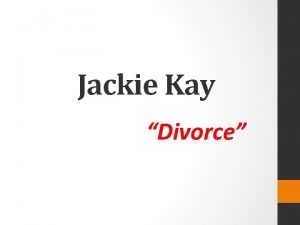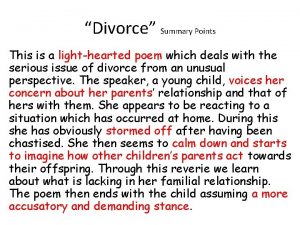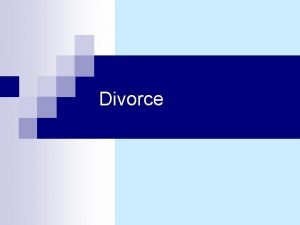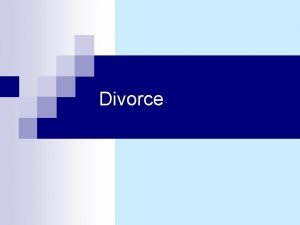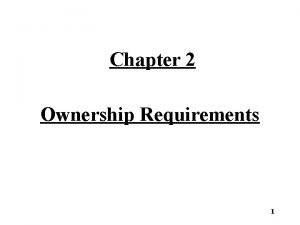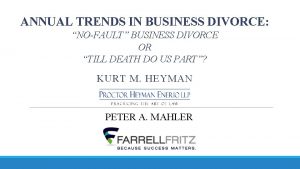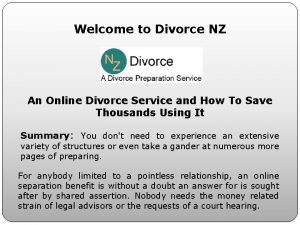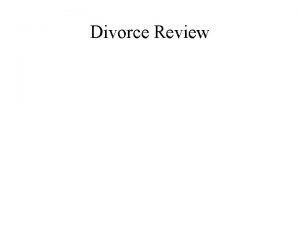The Divorce of Ownership Control A 2 Economics














- Slides: 14

The Divorce of Ownership & Control A 2 Economics Unit 3

Aims and Objectives Aim: • Understand the divorce of ownership and control. Objectives: • Describe the conflict in objectives between managers and shareholders. • Analyse the relationship between sales maximisation and profit maximisation. • Evaluate the pursuit of objectives in the long run and short run.

Starter • Split into groups – shareholders and managers of ASDA. • Decide on 4 objectives you wish to be achieved by ASDA as either a manger or a shareholder.

Conflict Between Objectives Shareholders Managers Profit Maximisation & Dividends Salaries, working conditions, job security, sales and employment

Divorce of Ownership & Control Shareholders Managers • Interested in profit maximisation and dividends. • Only interested in managers making profits. • Incentivised by money. • Salaries determined by size of firm. • May seek market size in terms of output, employment and sales rather than profitability. However, managers want to signal to shareholders that they are performing well and so chose not to profit maximise but to profit satisfice.

Profit Satisficing • The firm is producing satisfactory profits but not maximum profit. • Managers keep shareholders quite happy whilst being able to pursue their own objectives. • Some opportunity costs still exist though! Profits Ethics

Sales Maximisation Theory • Managers would rather work for large firms. • Greater benefits in terms of salary – sales bonuses. • Managers may increase sales up to the point where MR = 0 Price £s MR 0 D=AR Quantity

Sales Maximisation Theory • At this point the firms Price MC will be positive. £s • Firm not maximising profits. • Firm maximising sales revenue. • Reward goes to managers in the form of bonuses instead of profit to shareholders. MR 0 D=AR Quantity

Speed Dating • Using an AR/MR diagram explain to your date using your whiteboards, how the divorce of ownership and control may occur and how managers utility may be greater than shareholders.

EV: Can Firms Profit Maximise? • Firms need to know their MC as well as Eo. D. • Firms product ranges are so complex and MC data is rarely available. • Firms would also need to vary their prices to find profit max pt – which may lead to loss of custom. • Also a time lag between processing info and making decisions to profit maximise. • Almost impossible for a firm to know if its profit maximising!

Satisficing Vs Maximising • Firms are more likely to profit satisfice. • Make sufficient profits to keep shareholders happy, and not waste time and resources trying to find the maximising point.

Long Run Profit Maximisation • Sales are key to growth. • Growth is key to future profits and managerial security. • Firms unlikely to undertake short term risky strategies in case it jeopardises long run survival. • Firms are likely to be risk averse.

EV: Conclusion • If managers fail to make profits in SR the firm could be subject to a takeover. • ‘Capital Market Discipline’ takeovers of firms failing to make the profits their assets are capable of. • Limits the pursuit of other objectives than profit by managers. • Short run behaviour could be at the detriment of firm in long run. • Way around this: delist PLC from stock exchange!

Plenary 1) Give two reasons why firms may choose not to pursue profit maximisation. 2) Explain with the aid of a diagram why if managers are maximising sales, profits are not maximised.
 Divorce of ownership and control tutor2u
Divorce of ownership and control tutor2u Divorce of ownership and control
Divorce of ownership and control School of business and economics maastricht
School of business and economics maastricht Mathematical vs non mathematical economics
Mathematical vs non mathematical economics Malachi 2:15-16
Malachi 2:15-16 Surah nisa divorce
Surah nisa divorce Doll may shuns
Doll may shuns Functionalist perspective on divorce
Functionalist perspective on divorce Marriage and divorce presentation
Marriage and divorce presentation Divorce by jackie kay
Divorce by jackie kay Funny divorce poems
Funny divorce poems Objectives of divorce
Objectives of divorce Objectives of divorce
Objectives of divorce Divorce decision tree
Divorce decision tree Divorce busters
Divorce busters









